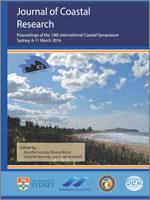Ruiz de Alegria-Arzaburu, A.; Arreola-Cortez, M.A.; García-Nava, H.; Hernández-Walls, R., and Mejía-Trejo, A., 2016. The effects of beach morphology variations on the profile of nearshore currents on a gently sloping mesotidal beach. In: Vila-Concejo, A.; Bruce, E.; Kennedy, D.M., and McCarroll, R.J. (eds.), Proceedings of the 14th International Coastal Symposium (Sydney, Australia). Journal of Coastal Research, Special Issue, No. 75, pp. 457–461. Coconut Creek (Florida), ISSN 0749-0208.
Concurrent measurements of subtidal beach morphology and profiles of nearshore currents have been collected over a year period on a gently sloping mesotidal beach in the northwestern coast of the Baja California peninsula in Mexico. Data collected in August 2014 and February 2015 during similar tide, wave and wind conditions are compared at different alongshore locations on the beach in order to determine differences on the vertical structure of the nearshore currents in relation to significant morphologic variations. The beach presents a clear seasonal variability, showing the formation of an inner sandbar during the winter as a result of the erosion of a large portion of the subaerial beach. The morphological differences on the inner subtidal beach shows a subsequent effect on the vertical structure of the nearshore currents. Locations with pronounced sandbars have generally associated cross-shore and longshore components of the current of larger magnitude. Generally, the surface and bottom cross-shore currents are the most energetic while the middle layer presents milder magnitudes. With the presence of an inner bar, the shoreward directed upper and bottom layers become wider (deeper) reducing the width of the middle less energetic layer, and after the breaking zone the water column becomes vertically quasi-homogeneous. This study contributes to the understanding of the feedbacks between the hydrodynamic forcing and the beach morphology.





